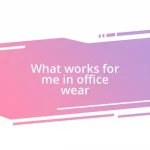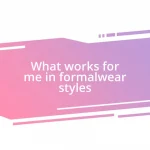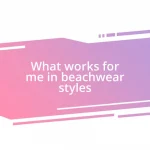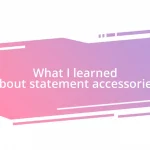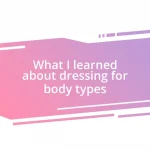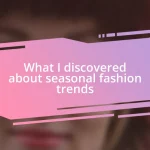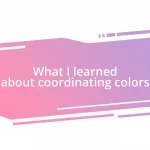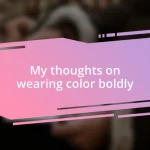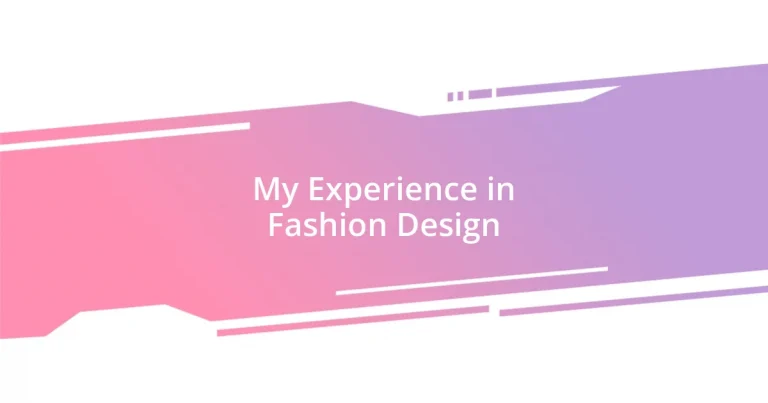Key takeaways:
- First encounter with fashion design sparked during a moment of mending a sweater, leading to exploration and sharing visions with others.
- Understanding fundamental design elements and market trends essential for creating relevant and expressive fashion pieces.
- Participating in competitions fosters community, growth, and resilience, highlighting the value of feedback and networking in a designer’s journey.
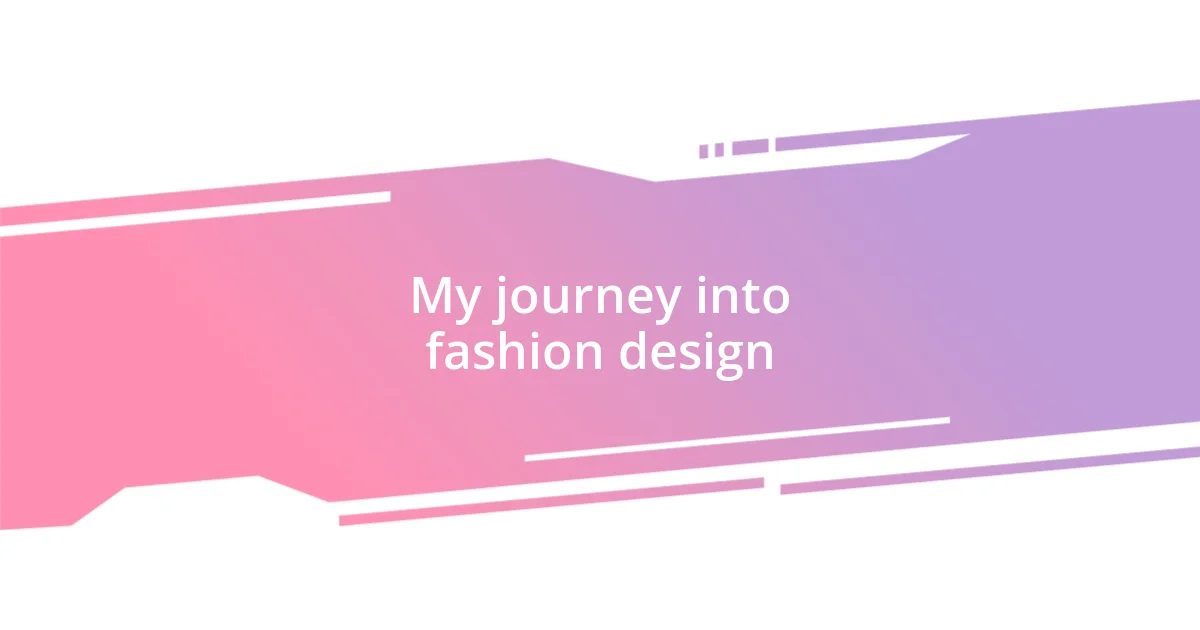
My journey into fashion design
I still remember the first time I picked up a needle and thread. It was a cold winter afternoon, and I was trying to mend my favorite sweater. That simple act sparked something in me. I wondered, “Could I create something entirely new?” That curiosity led me to explore fashion design.
As I delved deeper, I began sketching ideas inspired by everything around me—the colors of autumn leaves, the forms of urban architecture, and even the rhythm of music. I recall sitting in my favorite coffee shop, sketchbook open, when a barista asked me about my drawings. Her genuine interest made me realize how much I wanted to share my vision with the world.
One pivotal moment in my journey was my first fashion show. Standing backstage, surrounded by the energy and nerves of fellow designers, I felt a surge of excitement. I thought, “This is it! This is where I belong.” That night, as I watched my creations strut down the runway, I felt a profound connection to not just fashion, but to a community that shares my passion.
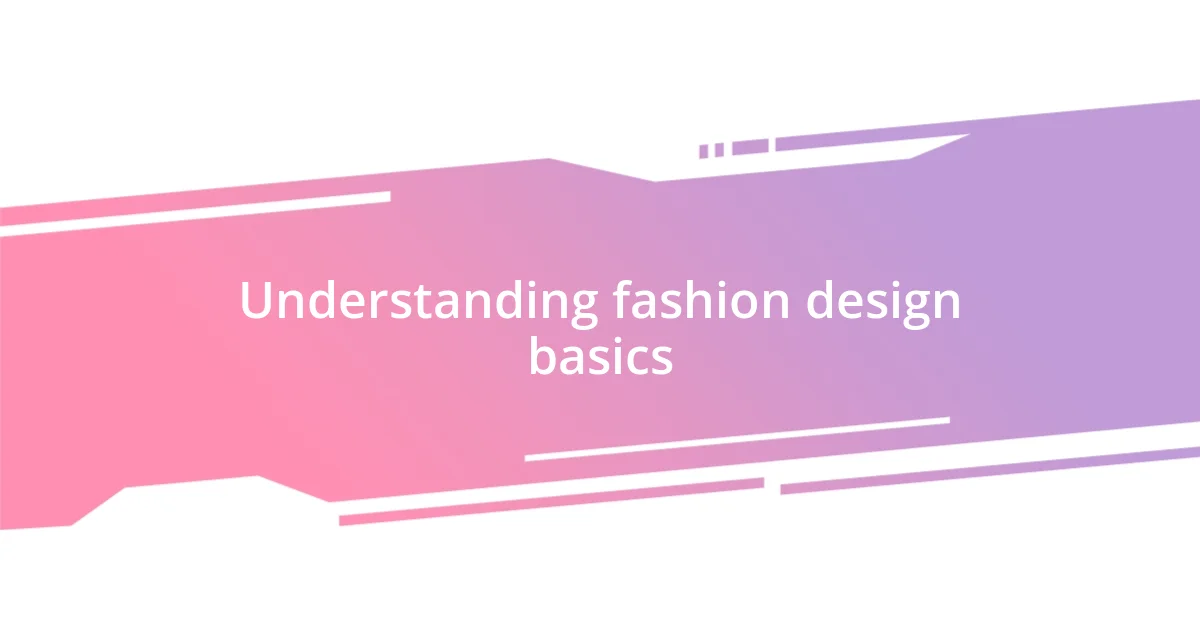
Understanding fashion design basics
Understanding the basic elements of fashion design is crucial for anyone interested in the field. I remember attending my first design class, where the instructor broke down the components of fashion—like silhouette, color, and texture. It felt like discovering the building blocks of creativity, each piece waiting to be combined in new and exciting ways.
One fascinating aspect of fashion design is the balance between artistry and practicality. While I enjoyed creating whimsical sketches, I quickly learned that translating those ideas into wearable garments required a keen understanding of fabric types and construction techniques. The first time I successfully turned a drawing into a physical piece, I felt an overwhelming sense of accomplishment. It’s a blend of dream and reality that keeps me passionate about fashion.
Furthermore, understanding trends and market demand plays a significant role in the design process. I recall researching past fashion cycles and comparing them to current influences. The evolution of styles always intrigued me, inspiring me to create designs that would resonate with the audience. Embracing this knowledge sharpened my perspective, enabling me to infuse my designs with relevance and personal expression.
| Element | Description |
|---|---|
| Silhouette | The overall shape or outline of a garment. |
| Color | The use of color can evoke emotions and set the tone of a design. |
| Texture | The feel or appearance of the fabric, adding depth to designs. |
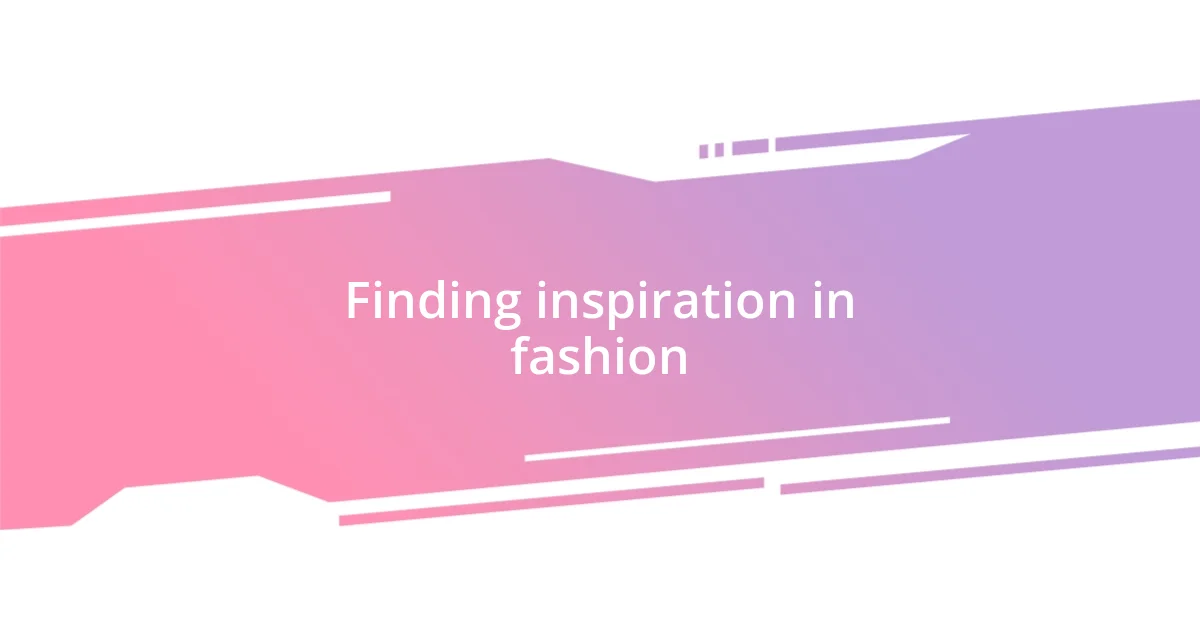
Finding inspiration in fashion
Finding inspiration in fashion often feels like embarking on a treasure hunt. I remember a sunny afternoon spent wandering through a local art gallery, completely captivated by an abstract painting. The vivid colors and bold strokes sparked an idea for a collection inspired by emotion and movement. Attraction to different art forms continuously shapes my designs, and I find that inspiration is often hidden in the most unexpected places.
Some of my favorite sources of inspiration include:
- Nature: The intricate patterns and colors found in flowers or landscapes can ignite whole collections.
- Cultural Heritage: Exploring traditional garments from different cultures often leads to unique design ideas infused with history.
- Personal Experiences: My own memories and stories provide rich material for designs that feel authentic and relatable.
- Street Fashion: Observing how individuals express their style on the streets can reveal emerging trends and personal touches that resonate with the public.
These moments of inspiration remind me that fashion isn’t just about clothing; it’s about storytelling through design. Every piece I create carries a narrative, and tapping into diverse influences enriches that story in ways I never expected.
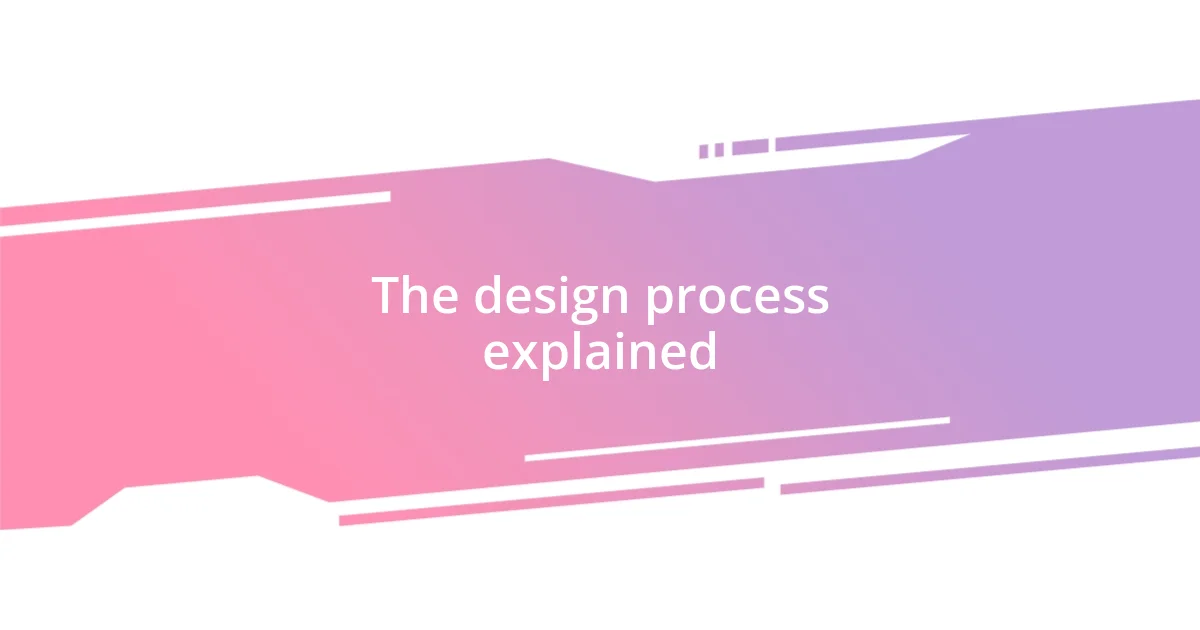
The design process explained
The design process is an intricate journey that begins with brainstorming ideas and sketching concepts. I still vividly recall myself huddled in my small studio, surrounded by crumpled papers filled with doodles and hasty notes as I tried to define the essence of my next collection. It’s exhilarating and frustrating all at once. Have you ever found yourself lost in a creative whirlwind, where every thought seems both brilliant and confusing? That’s exactly how it felt during those early stages of design.
Once I had my sketches, the next step involved choosing the right materials to bring my ideas to life. This part always fascinated me; selecting fabrics felt like picking the colors on a painter’s palette. I remember the first time I visited a fabric store and running my fingers across various textures. The sensory experience was overwhelming—I could actually feel the potential for each piece. How incredible it is that a simple fabric can transform into something that not only looks good but also feels good to wear!
After finalizing my material choices, the real magic happens during the construction phase, where everything comes together. I experienced this first-hand while watching a skilled seamstress transform my vision into reality. The intricate stitching and meticulous attention to detail were awe-inspiring. It was then I realized that design goes beyond aesthetics; it involves craftsmanship and passion too. Have you ever watched a creator at work and felt that spark of inspiration? That moment reinforces my belief that every stitch tells a story, and every garment carries with it the spirit of its designer.
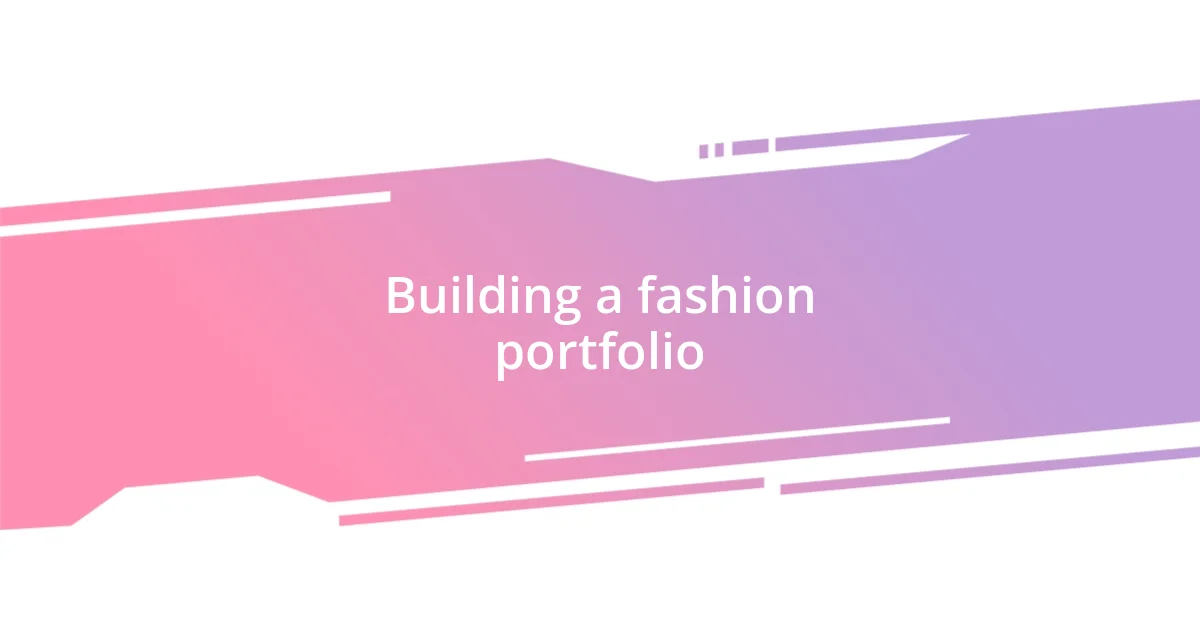
Building a fashion portfolio
Building a fashion portfolio is a crucial step in establishing your identity as a designer. It was during one of those late-night brainstorming sessions when I first began putting together my portfolio. I remember flipping through countless sketches and photographs, feeling both excitement and vulnerability. How do you encapsulate your vision in just a few pages? The challenge lies not just in showcasing your work but telling your unique story through it.
As I curated my portfolio, I strategically included not only completed designs but also concept sketches, fabric swatches, and even mood boards. This allowed potential clients and employers to see the entire creative process, which I found to be incredibly engaging. I believe that presenting the evolution of a design can spark interest and appreciation for the craftsmanship involved. Have you ever looked at someone’s portfolio and felt immediately drawn into their journey? That’s the effect I aimed for each time I polished mine.
Lastly, I learned the importance of tailoring my portfolio to my audience. For example, when approaching a high-end fashion house, I focused on elegance and meticulous craftsmanship, whereas for a more urban, streetwear brand, I highlighted my innovative, edgy designs. It felt liberating to adapt my work to resonate with different people. How do you communicate your vision to fit various styles? This adaptability not only showcases my versatility but also my dedication to the art of fashion design.
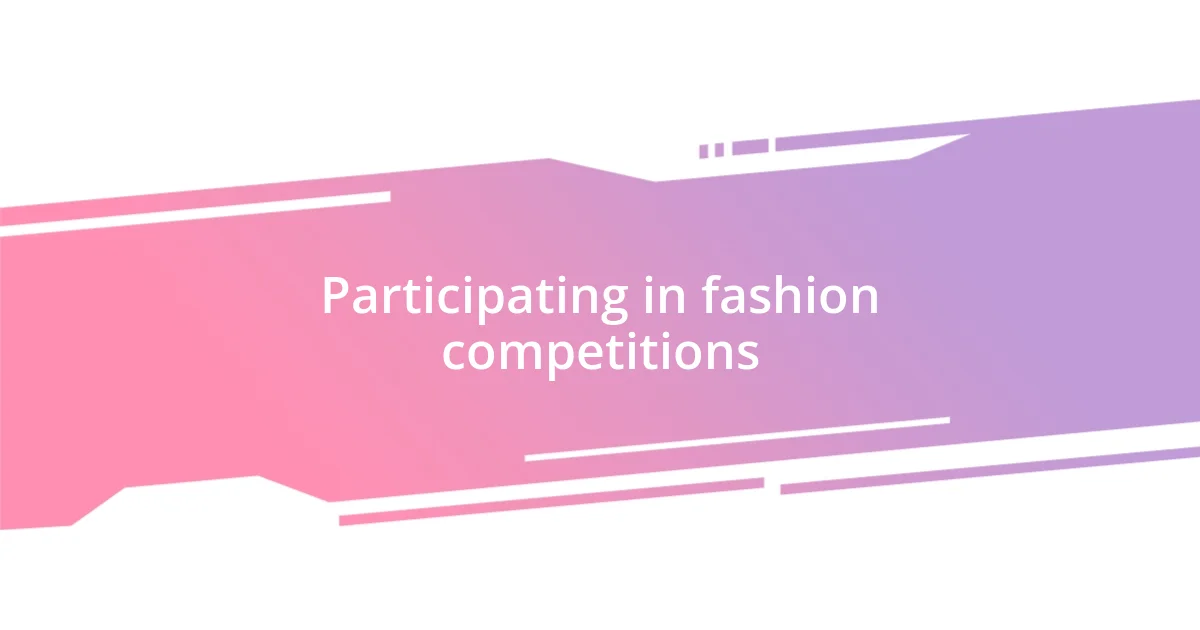
Participating in fashion competitions
Participating in fashion competitions can be a transformative experience for any designer. I remember my first competition vividly; the excitement was palpable as I prepared my collection. The adrenaline rush of presenting my work to a panel of experienced judges can only be described as exhilarating yet nerve-wracking. Have you ever felt that mix of anticipation and anxiety before a big moment? It really pushes you to refine your designs and express your vision clearly.
What struck me most was the sense of community within those competitions. Designers from various backgrounds came together, each sharing their unique stories and styles. I found inspiration in their creativity, and it was eye-opening to see how different interpretations of fashion could emerge from the same theme. Sharing your passion in that environment fosters not only growth but also friendships that can last a lifetime. Have you ever collaborated with someone and discovered unexpected creative synergy?
The feedback received from judges was invaluable, even when it stung. I remember one instance when a judge pointed out the flaws in my garment construction. Initially, I felt defensive, thinking, “They just don’t see my vision!” However, taking a step back, I realized those critiques were windows to improvement. It’s incredible how feedback—though often tough to digest—can shape you into a better designer. How do you handle constructive criticism? Embracing it has helped me grow beyond my wildest dreams.
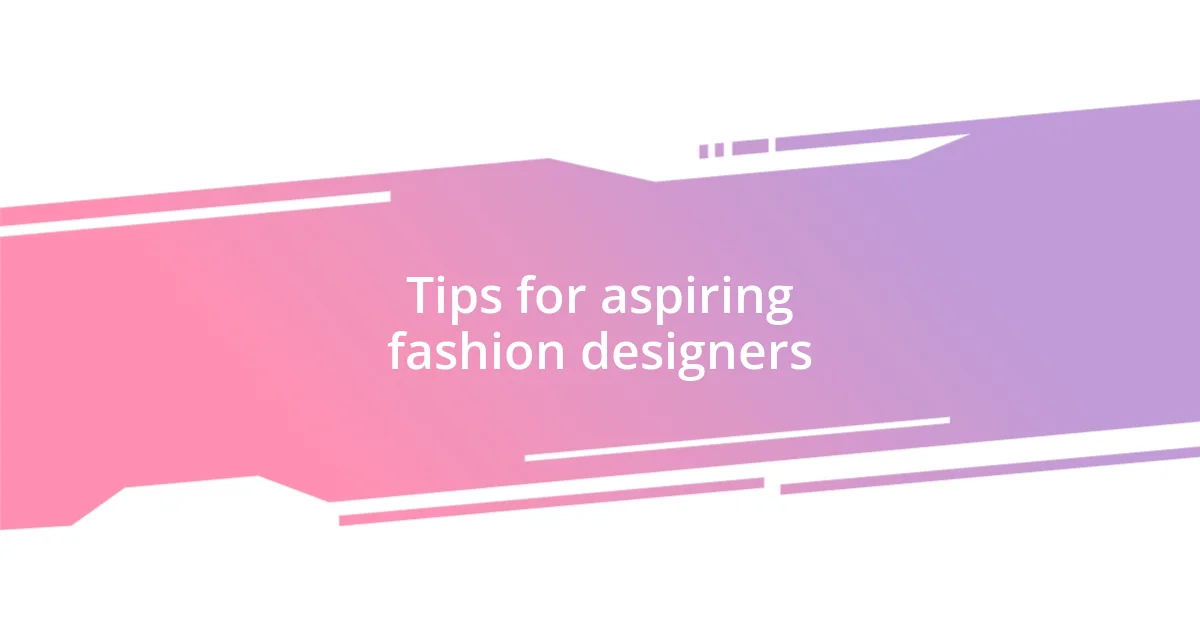
Tips for aspiring fashion designers
Finding your unique voice in fashion design is essential. I remember the moment I realized my style didn’t have to mimic the mainstream. It was during a late-night sketching session, surrounded by fabric swatches, when I instinctively gravitated towards bold colors and unconventional silhouettes. That epiphany felt liberating—how can you express your vision if you’re just following trends? Embracing originality not only attracts attention but also allows your true self to shine.
Networking is another vital aspect that often doesn’t receive enough attention. I’ll never forget my first networking event; I was nervous but knew the potential impact it could have on my career. Striking up conversations with established designers and fellow peers opened doors I never imagined. Have you ever walked into a room full of strangers and left with a sense of belonging? Those connections can lead to mentorship opportunities, collaborations, or even jobs. Don’t underestimate the power of a personal connection in this industry!
Lastly, I’ve learned that persistence is key. There were countless moments when I faced rejection—be it from schools, competitions, or potential employers. I vividly remember my heart sinking after receiving a rejection email that felt like a blow to my dreams. Yet, instead of wallowing, I used it as fuel to refine my designs and push further. How do you handle setbacks? Turning rejection into motivation is what separates aspiring designers from those who truly succeed. Keep pursuing your passion; every “no” takes you one step closer to a “yes.”
